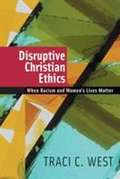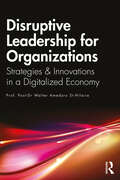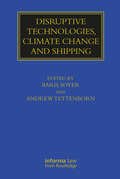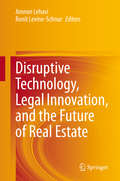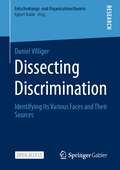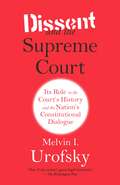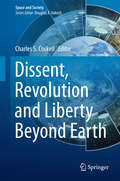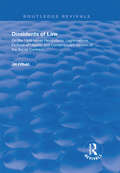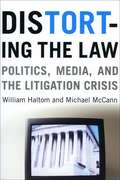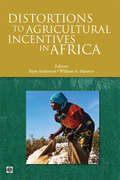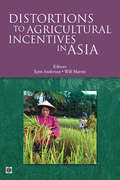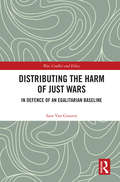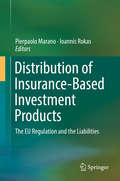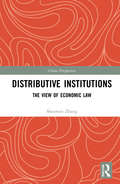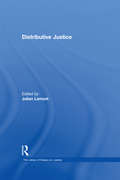- Table View
- List View
Disruptive Christian Ethics: When Racism and Women's Lives Matter
by Traci C. WestThis book brings to the fore the difficult realities of racism and the sexual violation of women. Traci West argues for a liberative method of Christian social ethics in which the discussion begins not with generic philosophical concepts but in the concrete realities of the lives of the socially and economically marginalized.
Disruptive Leadership for Organizations: Strategies & Innovations in a Digitalized Economy
by Walter Amedzro St-HilaireAimed as much at the neophyte as at the insider who questions why intellectual property rights (IPRs) matter in the digital age and the corporate strategies in the digitalised economy, this book approaches with perspicacity the development of disruptive mechanisms for organisations and IPR-centric leadership. The book is focused on organisations and a management systems perspective. The book identifies the technical practices and proposes multi-level strategies to promote disruptive leadership and encourage growth. The book then addresses the fundamentals of innovation and technology governance, from the production of ideas to the distribution of innovative products or services, including prototyping, financing, industrialisation and so on. It presents recent challenges, including open innovation, creativity and design thinking, and innovation of business models, placing them in the context of knowledge and the collaborative economy. The ambition of the book is to propose a framework for thought and action to the manager, which is composed of five walls – organisational creativity, intellectual property, financing, manufacturing and design of innovation – brought together under one roof, the business model of the technology. This device in which the manager must fit is situated in the strategy of his company and is to be embedded in a specific macroeconomic space.
Disruptive Technologies, Climate Change and Shipping (Maritime and Transport Law Library)
by Simon Baughen Andrew Tettenborn Bariş SoyerThis book analyses the impact of two vital and contemporary developments on shipping law and practice: disruptive technologies and climate change. It considers the impact of these new technologies, honing in on likely emerging issues and unresolved questions, especially about existing and potential private law liabilities and concentrates, from the point of view of English, EU and international law, on the legal implications of climate change and associated environmental risks in the shipping sector. Written by a contributor team drawn from the most experienced and knowledgeable academics and practitioners in shipping law, this treatment of these growing areas of practice will be of great use to lawyers and administrators across the world.
Disruptive Technology, Legal Innovation, and the Future of Real Estate
by Amnon Lehavi Ronit Levine-SchnurThis book addresses challenges that new technologies and the big data revolution pose to existing regulatory and legal frameworks. The volume discusses issues such as blockchain and its implications for property transactions and taxes, three (or four) dimensional title registration, land use and urban planning in the age of big data, and the future of property rights in light of these changes. The book brings together an interdisciplinary collection of chapters that revolve around the potential influence of disruptive technologies on existing legal norms and the future development of real estate markets. The book is divided into five parts. Part I presents a survey of the current available research on blockchain and real estate. Part II provides a background on property law for the volume, grounding it in fundamental theory. Part III discusses the changing landscapes of property rights while Part IV debates the potential effects of blockchain on land registration. Finally the book concludes with Part V, which is devoted to new technological applications relevant to real estate. Providing an interdisciplinary perspective on emerging technologies that have the potential to disrupt the real estate industry and the regulation of it, this book will appeal to a broad audience, consisting of scholars, policy-makers, practitioners, and students, interested in real estate, law, economics, blockchain, and technology policy.
Dissecting Discrimination: Identifying Its Various Faces and Their Sources (Entscheidungs- und Organisationstheorie)
by Daniel VilligerThis Open-Access-book examines the phenomenon of discrimination using a descriptive approach. Discrimination is omnipresent, whether it is people who discriminate against other people or, more recently, also machines that discriminate against people. The first part of the analysis employs decision theory on discrimination, leading to two fundamental subtypes: taste-based discrimination and statistical discrimination. The second part links taste-based discrimination to social identity theory, demonstrates that not all taste-based discrimination is ultimately statistical discrimination, and reveals the evolutionary origins of our tastes. The third part surveys how people get their beliefs for statistical discrimination and thereby shows that they often deviate from Bayesianism: they have inherent prior beliefs and do not exclusively update their beliefs according to Bayes’ law. Additionally, the analysis of belief formation highlights the importance of the learning environment. The last part reassembles the previously dissected aspects of discrimination, presents a new descriptive model of discrimination, and lists five implications for a normative theory of discrimination.
Dissent and the Supreme Court
by Melvin I. UrofskyFrom the admired judicial authority, author of Louis D. Brandeis ("Remarkable"--Anthony Lewis, The New York Review of Books; "Monumental"--Alan M. Dershowitz, The New York Times Book Review), Division and Discord, and Supreme Decisions--Melvin Urofsky's major new book looks at the role of dissent in the Supreme Court and the meaning of the Constitution through the greatest and longest lasting public-policy debate in the country's history, among members of the Supreme Court, between the Court and the other branches of government, and between the Court and the people of the United States. Urofsky writes of the necessity of constitutional dialogue as one of the ways in which we as a people reinvent and reinvigorate our democratic society. In Dissent and the Supreme Court, he explores the great dissents throughout the Court's 225-year history. He discusses in detail the role the Supreme Court has played in helping to define what the Constitution means, how the Court's majority opinions have not always been right, and how the dissenters, by positing alternative interpretations, have initiated a critical dialogue about what a particular decision should mean. This dialogue is sometimes resolved quickly; other times it may take decades before the Court adjusts its position. Louis Brandeis's dissenting opinion about wiretapping became the position of the Court four decades after it was written. The Court took six decades to adopt the dissenting opinion of the first Justice John Harlan in Plessy v. Ferguson (1896)--that segregation on the basis of race violated the Constitution--in Brown v. Board of Education (1954). Urofsky shows that the practice of dissent grew slowly but steadily and that in the nineteenth century dissents became more frequent. In the (in)famous case of Dred Scott v. Sanford (1857), Chief Justice Roger Taney's opinion upheld slavery, declaring that blacks could never be citizens. The justice received intense condemnations from several of his colleagues, but it took a civil war and three constitutional amendments before the dissenting view prevailed and Dred Scott was overturned. Urofsky looks as well at the many aspects of American constitutional life that were affected by the Earl Warren Court--free speech, race, judicial appointment, and rights of the accused--and shows how few of these decisions were unanimous, and how the dissents in the earlier cases molded the results of later decisions; how with Roe v. Wade--the Dred Scott of the modern era--dissent fashioned subsequent decisions, and how, in the Court, a dialogue that began with the dissents in Roe has shaped every decision since. Urofsky writes of the rise of conservatism and discusses how the resulting appointments of more conservative jurists to the bench put the last of the Warren liberals--William Brennan and Thurgood Marshall--in increasingly beleaguered positions, and in the minority. He discusses the present age of incivility, in which reasoned dialogue seems less and less possible. Yet within the Marble Palace, the members of the Supreme Court continue to hear arguments, vote, and draft majority opinions, while the minority continues to "respectfully dissent." The Framers understood that if a constitution doesn't grow and adapt, it atrophies and dies, and if it does, so does the democratic society it has supported. Dissent--on the Court and off, Urofsky argues--has been a crucial ingredient in keeping the Constitution alive and must continue to be so.(With black-and-white illustrations throughout.)From the Hardcover edition.
Dissent and the Supreme Court: Its Role in the Court's History and the Nation's Constitutional Dialogue
by Melvin I. UrofskyFrom the admired judicial authority, author of Louis D. Brandeis (“Remarkable”—Anthony Lewis, The New York Review of Books; “Monumental”—Alan M. Dershowitz, The New York Times Book Review), Division and Discord, and Supreme Decisions—Melvin Urofsky’s major new book looks at the role of dissent in the Supreme Court and the meaning of the Constitution through the greatest and longest lasting public-policy debate in the country’s history, among members of the Supreme Court, between the Court and the other branches of government, and between the Court and the people of the United States. Urofsky writes of the necessity of constitutional dialogue as one of the ways in which we as a people reinvent and reinvigorate our democratic society. In Dissent and the Supreme Court, he explores the great dissents throughout the Court’s 225-year history. He discusses in detail the role the Supreme Court has played in helping to define what the Constitution means, how the Court’s majority opinions have not always been right, and how the dissenters, by positing alternative interpretations, have initiated a critical dialogue about what a particular decision should mean. This dialogue is sometimes resolved quickly; other times it may take decades before the Court adjusts its position. Louis Brandeis’s dissenting opinion about wiretapping became the position of the Court four decades after it was written. The Court took six decades to adopt the dissenting opinion of the first Justice John Harlan in Plessy v. Ferguson (1896)—that segregation on the basis of race violated the Constitution—in Brown v. Board of Education (1954). Urofsky shows that the practice of dissent grew slowly but steadily and that in the nineteenth century dissents became more frequent. In the (in)famous case of Dred Scott v. Sanford (1857), Chief Justice Roger Taney’s opinion upheld slavery, declaring that blacks could never be citizens. The justice received intense condemnations from several of his colleagues, but it took a civil war and three constitutional amendments before the dissenting view prevailed and Dred Scott was overturned. Urofsky looks as well at the many aspects of American constitutional life that were affected by the Earl Warren Court—free speech, race, judicial appointment, and rights of the accused—and shows how few of these decisions were unanimous, and how the dissents in the earlier cases molded the results of later decisions; how with Roe v. Wade—the Dred Scott of the modern era—dissent fashioned subsequent decisions, and how, in the Court, a dialogue that began with the dissents in Roe has shaped every decision since. Urofsky writes of the rise of conservatism and discusses how the resulting appointments of more conservative jurists to the bench put the last of the Warren liberals—William Brennan and Thurgood Marshall—in increasingly beleaguered positions, and in the minority. He discusses the present age of incivility, in which reasoned dialogue seems less and less possible. Yet within the Marble Palace, the members of the Supreme Court continue to hear arguments, vote, and draft majority opinions, while the minority continues to “respectfully dissent.” The Framers understood that if a constitution doesn’t grow and adapt, it atrophies and dies, and if it does, so does the democratic society it has supported. Dissent—on the Court and off, Urofsky argues—has been a crucial ingredient in keeping the Constitution alive and must continue to be so.(With black-and-white illustrations throughout.)From the Hardcover edition.
Dissent and the Supreme Court: Its Role in the Court's History and the Nation's Constitutional Dialogue
by Melvin I. UrofskyFrom the admired judicial authority, author of Louis D. Brandeis (“Remarkable”—Anthony Lewis, The New York Review of Books; “Monumental”—Alan M. Dershowitz, The New York Times Book Review), Division and Discord, and Supreme Decisions—Melvin Urofsky’s major new book looks at the role of dissent in the Supreme Court and the meaning of the Constitution through the greatest and longest lasting public-policy debate in the country’s history, among members of the Supreme Court, between the Court and the other branches of government, and between the Court and the people of the United States. Urofsky writes of the necessity of constitutional dialogue as one of the ways in which we as a people reinvent and reinvigorate our democratic society. In Dissent and the Supreme Court, he explores the great dissents throughout the Court’s 225-year history. He discusses in detail the role the Supreme Court has played in helping to define what the Constitution means, how the Court’s majority opinions have not always been right, and how the dissenters, by positing alternative interpretations, have initiated a critical dialogue about what a particular decision should mean. This dialogue is sometimes resolved quickly; other times it may take decades before the Court adjusts its position. Louis Brandeis’s dissenting opinion about wiretapping became the position of the Court four decades after it was written. The Court took six decades to adopt the dissenting opinion of the first Justice John Harlan in Plessy v. Ferguson (1896)—that segregation on the basis of race violated the Constitution—in Brown v. Board of Education (1954). Urofsky shows that the practice of dissent grew slowly but steadily and that in the nineteenth century dissents became more frequent. In the (in)famous case of Dred Scott v. Sanford (1857), Chief Justice Roger Taney’s opinion upheld slavery, declaring that blacks could never be citizens. The justice received intense condemnations from several of his colleagues, but it took a civil war and three constitutional amendments before the dissenting view prevailed and Dred Scott was overturned. Urofsky looks as well at the many aspects of American constitutional life that were affected by the Earl Warren Court—free speech, race, judicial appointment, and rights of the accused—and shows how few of these decisions were unanimous, and how the dissents in the earlier cases molded the results of later decisions; how with Roe v. Wade—the Dred Scott of the modern era—dissent fashioned subsequent decisions, and how, in the Court, a dialogue that began with the dissents in Roe has shaped every decision since. Urofsky writes of the rise of conservatism and discusses how the resulting appointments of more conservative jurists to the bench put the last of the Warren liberals—William Brennan and Thurgood Marshall—in increasingly beleaguered positions, and in the minority. He discusses the present age of incivility, in which reasoned dialogue seems less and less possible. Yet within the Marble Palace, the members of the Supreme Court continue to hear arguments, vote, and draft majority opinions, while the minority continues to “respectfully dissent.” The Framers understood that if a constitution doesn’t grow and adapt, it atrophies and dies, and if it does, so does the democratic society it has supported. Dissent—on the Court and off, Urofsky argues—has been a crucial ingredient in keeping the Constitution alive and must continue to be so.(With black-and-white illustrations throughout.)From the Hardcover edition.
Dissent on Core Beliefs: Religious and Secular Perspectives (The Ethikon Series in Comparative Ethics)
by Peter Nosco Simone ChambersDifference, diversity and disagreement are inevitable features of our ethical, social and political landscape. This collection of new essays investigates the ways that various ethical and religious traditions have dealt with intramural dissent; the volume covers nine separate traditions: Confucianism, Buddhism, Christianity, Judaism, Islam, liberalism, Marxism, South Asian religions and natural law. Each chapter lays out the distinctive features, history and challenges of intramural dissent within each tradition, enabling readers to identify similarities and differences between traditions. The book concludes with an Afterword by Michael Walzer, offering a synoptic overview of the challenge of intramural dissent and the responses to that challenge. Committed to dialogue across cultures and traditions, the collection begins that dialogue with the common challenges facing all traditions: how to maintain cohesion and core values in the face of pluralism, and how to do this in a way that is consistent with the internal ethical principles of the traditions. Each essay uses contemporary as well as historical illustrations to tackle questions of pluralism and dissent. Discusses multiple religious and ethical traditions in an accessible way. The chapters employ a common rubric facilitating comparison across essays and across traditions.
Dissent, Injustice, and the Meanings of America
by Steven H. ShiffrinAmericans should not just tolerate dissent. They should encourage it. In this provocative and wide-ranging book, Steven Shiffrin makes this case by arguing that dissent should be promoted because it lies at the heart of a core American value: free speech. He contends, however, that the country's major institutions--including the Supreme Court and the mass media--wrongly limit dissent. And he reflects on how society and the law should change to encourage nonconformity. Shiffrin is one of the country's leading first-amendment theorists. He advances his dissent-based theory of free speech with careful reference to its implications for such controversial topics of constitutional debate as flag burning, cigarette advertising, racist speech, and subsidizing the arts. He shows that a dissent-based approach would offer strong protection for free speech--he defends flag burning as a legitimate form of protest, for example--but argues that it would still allow for certain limitations on activities such as hate speech and commercial speech. Shiffrin adds that a dissent-based approach reveals weaknesses in the approaches to free speech taken by postmodernism, Republicanism, deliberative democratic theory, outsider jurisprudence, and liberal theory. Throughout the book, Shiffrin emphasizes the social functions of dissent: its role in combating injustice and its place in cultural struggles over the meanings of America. He argues, for example, that if we took a dissent-based approach to free speech seriously, we would no longer accept the unjust fact that public debate is dominated by the voices of the powerful and the wealthy. To ensure that more voices are heard, he argues, the country should take such steps as making defamation laws more hospitable to criticism of powerful people, loosening the grip of commercial interests on the media, and ensuring that young people are taught the importance of challenging injustice. Powerfully and clearly argued, Shiffrin's book is a major contribution to debate about one of the most important subjects in American public life.
Dissent, Revolution and Liberty Beyond Earth
by Charles S. CockellThis volume provides an in-depth discussion on the central question - how can people express and survive dissent and disagreement in confined habitats in space? The discussion is an important one because it could be that the systems of inter-dependence required to survive in space are so strong that dissent becomes impossible. John Locke originally said that people have a right to use revolution to overthrow a despotic regime. But if revolution causes violence and damage that causes depressurisation with the risk of killing many people, is it even permissible to have a revolution? How then are people to express their liberty or dissatisfaction with their rulers? The emergence of structures of dissent and disagreement is an essential part of the construction of a framework of liberty in space (revolution is just the extreme example) and thus the topic deserves in-depth and immediate attention. Even today, the way in which we assemble organisations and corporations for the government and private exploration of space must take into account the need for mechanisms to allow people to express dissent.
Dissent: The Radicalization of the Republican Party and Its Capture of the Court
by Jackie CalmesFeaturing new interviews with his accusers and overlooked evidence of his deceptions, a deeply reported account of the life and confirmation of Brett Kavanaugh, set against the conservative movement's capture of the courts.In DISSENT, award-winning investigative journalist Jackie Calmes brings readers closer to the truth of who Supreme Court Justice Brett Kavanaugh is, where he came from, and how he and the Republican party at large managed to secure one of the highest seats of power in the land.Kavanaugh's rise to the justice who solidified conservative control of the supreme court is a story of personal achievement, but also a larger, political tale: of the Republican Party's movement over four decades toward the far right, and its parallel campaign to dominate the government's judicial branch as well as the other two.And Kavanaugh uniquely personifies this history. Fourteen years before reaching the Supreme Court, during a three-year fight for a seat on the D.C. Circuit Court of Appeals, Democratic Senator Dick Durbin would say to Kavanaugh, "It seems that you are the Zelig or Forrest Gump of Republican politics. You show up at every scene of the crime."Featuring revelatory new reporting and exclusive interviews, DISSENT is a harrowing look into the highest echelons of political power in the United States, and a captivating survey of the people who will do anything to have it.
Dissenting Voices in American Society: The Role of Judges, Lawyers, and Citizens
by Austin SaratDissenting Voices in American Society: The Role of Judges, Lawyers, and Citizens explores the status of dissent in the work and lives of judges, lawyers, and citizens, and in our institutions and culture. It brings together under the lens of critical examination dissenting voices that are usually treated separately: the protester, the academic critic, the intellectual, and the dissenting judge. It examines the forms of dissent that institutions make possible and those that are discouraged or domesticated. This book also describes the kinds of stories that dissenting voices try to tell and the narrative tropes on which those stories depend. In what voices and tones do dissenting voices speak? What worlds does dissent try to imagine and what in the end is the value of dissent? Where does dissent speak without actually speaking? Where do dissenting voices most often go unheard or unrecognized? Do we find dissent wherever we find discontent? Wherever we find expression? This book is the product of an integrated series of symposia at the University of Alabama School of Law. These symposia bring leading scholars into colloquy with faculty at the law school on subjects at the cutting edge of interdisciplinary inquiry in law.
Dissidents of Law: On the 1989 Velvet Revolutions, Legitimations, Fictions of Legality and Contemporary Version of the Social Contract (Routledge Revivals)
by Jirí PribánThis title was first published in 2003: The problem of legitimacy and legality is one of the key issues of modern thought and nowhere more intensely debated than in the countries of the former Soviet bloc. Under the communist system, symbols of modern government had been supplemented and changed in order to serve the totalitarian domination of the Party and all spheres of life, including law, were subsumed within this framework of ideological legitimation. Following the anti-communist revolutions of 1989, former communist societies started the historically unprecedented process of transformation from the totalitarian into liberal democratic society, a transformation which has produced much soul-searching and heated debate. In this book, the author sets out to prove that concern with legitimacy belongs neither exclusively to the legal system nor to a political system separated and distanced from the legal system. The topic of legitimacy and legitimation is inseparable from legality and every legitimation eventually looks for its transformation into legal legitimacy.
Dissimulation and Deceit in Early Modern Europe
by Miriam Eliav-Feldon Tamar HerzigIn this book, twelve scholars of early modern history analyse various categories and cases of deception and false identity in the age of geographical discoveries and of forced conversions: from two-faced conversos to serial converts, from demoniacs to stigmatics, and from self-appointed ambassadors to lying cosmographer.
Distant Strangers
by Judith LichtenbergWhat must affluent people do to alleviate global poverty? This question has occupied moral and political philosophers for forty years. But the controversy has reached an impasse: approaches like utilitarianism and libertarianism either demand too much of ordinary mortals or else let them off the hook. In Distant Strangers, Judith Lichtenberg shows how a preoccupation with standard moral theories and with the concepts of duty and obligation have led philosophers astray. She argues that there are serious limits to what can be demanded of ordinary human beings, but this does not mean we must abandon the moral imperative to reduce poverty. Drawing on findings from behavioral economics and psychology, she shows how we can motivate better-off people to lessen poverty without demanding unrealistic levels of moral virtue. Lichtenberg argues convincingly that this approach is not only practically, but morally, appropriate.
Distorting the Law: Politics, Media, and the Litigation Crisis (Chicago Series In Law And Society Ser.)
by William Haltom Michael McCannIn recent years, stories of reckless lawyers and greedy citizens have given the legal system, and victims in general, a bad name. Many Americans have come to believe that we live in the land of the litigious, where frivolous lawsuits and absurdly high settlements reign. Scholars have argued for years that this common view of the depraved ruin of our civil legal system is a myth, but their research and statistics rarely make the news. William Haltom and Michael McCann here persuasively show how popularized distorted understandings of tort litigation (or tort tales) have been perpetuated by the mass media and reform proponents. Distorting the Law lays bare how media coverage has sensationalized lawsuits and sympathetically portrayed corporate interests, supporting big business and reinforcing negative stereotypes of law practices. Based on extensive interviews, nearly two decades of newspaper coverage, and in-depth studies of the McDonald's coffee case and tobacco litigation, Distorting the Law offers a compelling analysis of the presumed litigation crisis, the campaign for tort law reform, and the crucial role the media play in this process.
Distortions to Agricultural Incentives in Africa
by Kym Anderson William A. MastersThe vast majority of the world's poorest households depend on farming for their livelihoods. During the 1960s and 1970s, most developing countries imposed pro-urban and anti-agricultural policies, while many high-income countries restricted agricultural imports and subsidized their farmers. Both sets of policies inhibited economic growth and poverty alleviation in developing countries. Although progress has been made over the past two decades to reduce those policy biases, many trade- and welfare-reducing price distortions remain between agriculture and other sectors and within the agricultural sector of both rich and poor countries. Comprehensive empirical studies of the disarray in world agricultural markets appeared approximately 20 years ago. Since then, the Organisation for Economic Co-operation and Development has provided estimates each year of market distortions in high-income countries, but there have been no comparable estimates for the world's developing countries. This volume is the third in a series (other volumes cover Asia, Europe's transition economies, and Latin America and the Caribbean) that not only fills that void for recent years but extends the estimates in a consistent and comparable way back in time-and provides analytical narratives for scores of countries that shed light on the evolving nature and extent of policy interventions over the past half-century. 'Distortions to Agricultural Incentives in Africa' provides an overview of the evolution of distortions to agricultural incentives caused by price and trade policies in the Arab Republic of Egypt plus 20 countries that account for about of 90 percent of Sub-Saharan Africa's population, farm households, agricultural output, and overall GDP. Sectoral, trade, and exchange rate policies in the region have changed greatly since the 1950s, and there have been substantial reforms since the 1980s. Nonetheless, numerous price distortions in this region remain, others have been added in recent years, and there has also been some backsliding, such as in Zimbabwe. The new empirical indicators in these country studies provide a strong evidence-based foundation for assessing the successes and failures of the past and for evaluating policy options for the years ahead.
Distortions to Agricultural Incentives in Asia
by Kym Anderson Will MartinThe vast majority of the world's poorest households depend on farming for their livelihoods. During the 1960s and 1970s, most developing countries imposed pro-urban and anti-agricultural policies, while many high-income countries restricted agricultural imports and subsidized their farmers. Both sets of policies inhibited economic growth and poverty alleviation in developing countries. Although progress has been made over the past two decades to reduce those policy biases, many trade- and welfare-reducing price distortions remain between agriculture and other sectors and within the agricultural sector of both rich and poor countries. Comprehensive empirical studies of the disarray in world agricultural markets appeared approximately 20 years ago. Since then, the Organisation for Economic Co-operation and Development had provided estimates each year of market distortions in high-income countries, but there have been no comparable estimates for the world's developing countries. This volume is the third in a series (other volumes cover Africa, Europe's transition economics, and Latin America and the Caribbean) that not only fills that void for recent years but extends the estimates in a consistent and comparable way back in time-and provides analytical narratives for scores of countries that shed light on the evolving nature and extent of policy interventions over the past half-century. 'Distortions to Agricultural Incentives in Asia' provides an overview of the evolution of distortions to agricultural incentives caused by price and trade policies in the 12 largest economies of East and South Asia. Together these countries constitute more than 95 percent of the region's population, agricultural output, and overall GDP. Sectoral, trade, and exchange rate policies in the region have changed greatly since the 1950s, and there have been substantial reforms since the 1980s, most notably in China and India. Nonetheless, numerous price distortions in this region remain and others have added in recent years. The new empirical indicators in these country studies provide a strong evidence-based foundation for assessing the successes and failures of the past and for evaluating policy options for the years ahead.
Distributing the Harm of Just Wars: In Defence of an Egalitarian Baseline Approach (War, Conflict and Ethics)
by Sara Van GoozenThis book argues that the risk of harm in armed conflict should be divided equally between combatants and enemy non-combatants. International law requires that combatants in war take ‘all feasible precautions’ to minimize damage to civilian objects, injury to civilians, and incidental loss of civilian life. However, there is no clear explanation of what ‘feasible precautions’ means in this context, or what would count as sufficiently minimised incidental harm. As a result, it is difficult to judge whether a particular war or offensive actually satisfies this requirement. Just war theorists often consider it common sense that merely not intending to harm innocent civilians is not sufficient, but there is little clarity in the literature regarding what this means. One crucial question that is almost always overlooked is that of what the appropriate baseline distribution of risk should be. This book defends the Minimal Harm Requirement (MHR), which states that combatants should make an effort to reduce merely foreseen harm to enemy non-combatants to the lowest reasonable level. In order to assess which risk impositions are reasonable, and which are not, an egalitarian baseline should be adopted, suggesting that other things being equal risk of harm should be distributed equally between just combatants and unjust non-combatants. This book will be of much interest to students of just war theory, ethics, security studies and international relations.
Distribution of Insurance-Based Investment Products: The EU Regulation and the Liabilities
by Pierpaolo Marano Ioannis RokasThe book addresses a topic at the intersection of two heavily regulated sectors: insurance and investment services. Until recently, scholars and professionals have approached insurance and investment services as two separate categories in the financial services sector, and as being governed by separate regulatory frameworks. In practice, however, the boundaries were and are blurred, a reality that regulators have begun to recognize and address in their more recent regulatory texts. The first part of the book approaches the new standards applicable to investment products based on insurance: insurance-based investment products (IBIPs). These rules are harmonized across the EU. The rationale behind this new definition is provided, together with a description of these products’ limitations. The analysis addresses the new rules and explores the legal regime and relevant standards applicable to IBIPs. The organizational rules concerning the design and distribution of IBIPs are also examined, and the book highlights e.g. how these rules are inspired by the principles of conduct. In closing, the ADR systems are analysed, in order to ascertain whether or not they can offer an effective tool for settling disputes over these products. In turn, the second part focuses on the liability for distribution of IBIPs, which ranks as one of the most conspicuous and relatively new legal phenomena, but at the same time, represents an exceptionally important field of civil liability in today’s world. Liability is still regulated at the national level. Thus, the four largest life insurance markets in the EU are considered, along with the largest emerging market for life insurance. The chapters on national laws also consider whether, and if so, how the new harmonized rules on IBIPs are being combined with those already in force in the jurisdictions considered. The goal is to determine whether the new rules are likely to change the doctrine and case law approach to these products, or whether the European legislators’ choices have no real impact on the protection of clients.
Distribution of Responsibilities in International Law (Shared Responsibility in International Law)
by André Nollkaemper Dov JacobsThis is the second book in the series Shared Responsibility in International Law, which examines the problem of distribution of responsibilities among multiple states and other actors. In its work on the responsibility of states and international organisations, the International Law Commission recognised that attribution of acts to one actor does not exclude possible attribution of the same act to another state or organisation. However, it provided limited guidance for the often complex question of how responsibility is to be distributed among wrongdoing actors. This study fills that gap by shedding light on principles of distribution from extra-legal perspectives. Drawing on disciplines such as political theory, moral philosophy, and economics, this volume enquires into the bases and justifications for apportionment of responsibilities that can support a critique of current international law, offers insight into the justification of alternative interpretations, and provides inspiration for reform and further development of international law. Examines the conceptual and theoretical underpinnings of how responsibility is distributed among wrongdoing actors. Explains normative choices that inevitably underlie particular legal decisions on distribution from extra-legal perspectives. Brings together multiple perspectives from different disciplines and makes comparisons between multiple options for distributing responsibility under international law.
Distributive Institutions: The View of Economic Law (China Perspectives)
by Shouwen ZhangThe crisis of distribution is one of the longest standing and most complicated issues facing human society. Imbued with social, political, historic, and cultural elements, it varies significantly across different countries as a result of all these factors. As an emerging economy which transferred from a planned to a market economy, China has experienced large distribution gaps since it implemented the Reform and Opening-up Policy in the early 1980s, requiring stronger economic law to mitigate and regulate the crisis of distribution. In this second volume, the author analyses crises of distribution from a theoretical perspective and proposes law and policy solutions. Believing that such crises are a collective result of systematic limitations, the author proposes a theoretical framework of “system–distribution–development” in order to resolve distribution problems and promote economic development. He argues that a crisis of distribution cannot be avoided without coordinated development of economic law and relevant constitutional, civil, and commercial law systems. In addition, it is necessary to differentiate the territories, industries, enterprises, and individuals that constitute such diverse systems. The book should be of keen interest to researchers and students of law, economics, and political science.
Distributive Justice (The Library of Essays on Justice)
by Julian LamontA central component of justice is how the economic goods are distributed in a society. Philosophers contribute to distributive justice debates by providing arguments for principles to guide and evaluate the allocation of economic goods and to guide the design of institutions to achieve more just distributions. This volume includes both seminal and recent work by philosophers, covering a range of representative positions, including libertarian, egalitarian, desert, and welfare theorists. The introduction to the volume and the selections themselves are designed to allow students and professionals to see some of the most influential pieces that have shaped the field, as well as some key critics of these positions. The articles intersect in such a way as to develop an appreciation of the types of theories and the central issues addressed by theories of distributive justice. Furthermore, the choice of authors in this collection reflects an appreciation of the influence of institutions in general, markets in particular, and even luck on the distribution of economic goods.
Distributive Justice and Access to Advantage
by Alexander KaufmanG. A. Cohen was one of the world's leading political theorists. He was noted, in particular, for his contributions to the literature of egalitarian justice. Cohen's classic writings offer one of the most influential responses to the currency of the egalitarian justice question – the question, that is, of whether egalitarians should seek to equalize welfare, resources, opportunity, or some other indicator of well-being. Underlying Cohen's argument is the intuition that the purpose of egalitarianism is to eliminate disadvantage for which it is inappropriate to hold the person responsible. His argument therefore focuses on the appropriate role of considerations regarding responsibility in egalitarian judgment. This volume comprises chapters by major scholars addressing and responding both to Cohen's account of the currency of egalitarian justice and its practical implications and to Cohen's arguments regarding the appropriate form of justificatory arguments about justice.
